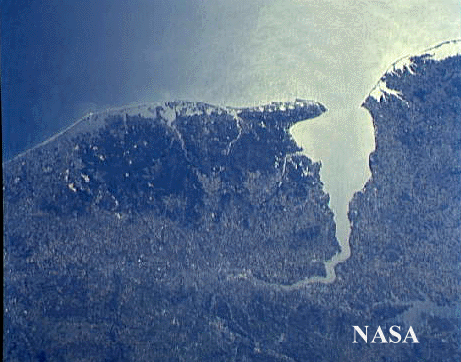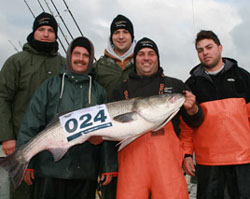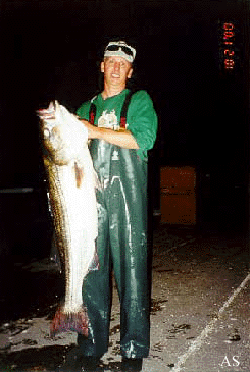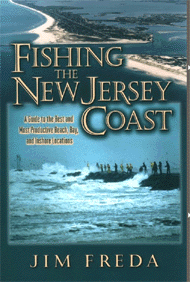
Delaware Bay and Delaware River

Delaware Bay (From Space)
The entrance to the Delaware Bay is bordered by Cape May to the north and Cape Henelopen at the south. The Bay is fed by the Delaware River.
Striped Bass Fishing in Delaware Bay
The ferry ride from Cape May, New Jersey to Lewis, Delaware across the mouth of the Bay is 17 miles. Although, in most places the water in the mouth of the Bay is deep, at least 35 feet in the channel, there are places where shoals result in water only 3 feet deep at low tide. In these areas, the moving water during the tides creates rip currents. Striped bass hang out there preying on baitfish that are swept past, and that become disoriented by the turbulent water. These are the famous "Cape May Rips." Every year, in both the spring and the fall, many stripers including some very large ones, are caught there.

Team Insufishent Funds 38
2007 Cape May NJ, ASA Winner
The main technique used to catch stripers in "The Rips," is to drift live eels through the rips. Either the incoming or outgoing tide are good for drifting through the rips. The important thing is that the water is moving. The best times, however, are near the beginnings and ends of the tide when the water is moving, but not too fast. Then you can get your eel down deep without using excessive weight, and also keep the eel in the zone where the fish are for a longer period of time. Some skilled boat captains use a technique called "stemming," where the boat motor is used to offset the effects of both current and wind to control the drifting speed.
Fishermen also troll deep along the edges of the shoals that form the Rips, using large lures like a "Mann's Stretch 25."
The 2007 American Striper Association's Striped Bass Tournament Trail included two stops in Delaware Bay: one in the spring and one in the fall. On these stops, the ASA used the Cape May South Jersey Marina as their base, and many of the tournament contestants fished the Cape May Rips.
The shoals that cause the Cape May Rips are marked so that deep draft ships can avoid them. Most have names, such as: Eph Shoal, Middle Shoal, Pressy Wicks Shoal, Somers Shoal and Overfalls Shoal.

39 pound striper
caught in the
Delaware Bay
Striper fishing back further in the bay can also be outstanding. There the most popular and effective technique is chunking with fresh bunker. Usually fishermen anchor and use chum to form a slick, and draw the stripers to the boat. Although all the chunks except the tail of a bunker are used, the largest stripers are often caught using the head. The 39-pound striper shown to the right was caught in the Delaware Bay on a bunker head.
Some productive locations for chunking for stripers in the Bay are:
The Horseshoe, Tussey's Slough, Bug Light, 60-Foot Slough, 20-Foot Slough, Cross Ledge,
Ship John,
and Bouys 19, 32 and 34. Surf fishermen can get in on the striper action from the bulkhead in Fortescue, and from
Gandy's Beach, Reed's Beach and East Point.
Good spots to chunk on the Delaware side of the Bay include the Coral Beds off Slaughter Beach and the Broadkill Slough.
Striped Bass Spawning in the Delaware River
In the spring, stripers go up the Delaware River to spawn and to chase River Herring. Up near the turnpike bridge, and also below the falls at Trenton, fishermen snag the herring and use them to liveline for stripers. I hope they release the stripers because these are the ones that are in the process of spawning.
The shores of the bay are largely composed of salt marshes and mud flats. This type of shoreline, plus the fact that the bay is fed my numerous rivers and streams in addition to the Delaware River, make it an ideal estuary and nursery for striped bass. Although the Chesapeake Bay and the Hudson River are the most well known spawning grounds for stripers, a significant number of striped bass grow up in the Delaware Bay.
Delaware Bay is also noted for black drum and weakfish. However, the weakfish population has declined in recent years.
Delaware Bay Video
To see a video about Delaware Bay Striped Bass Fishing, follow this Link:
Striped Bass Fishing in Delaware Bay
